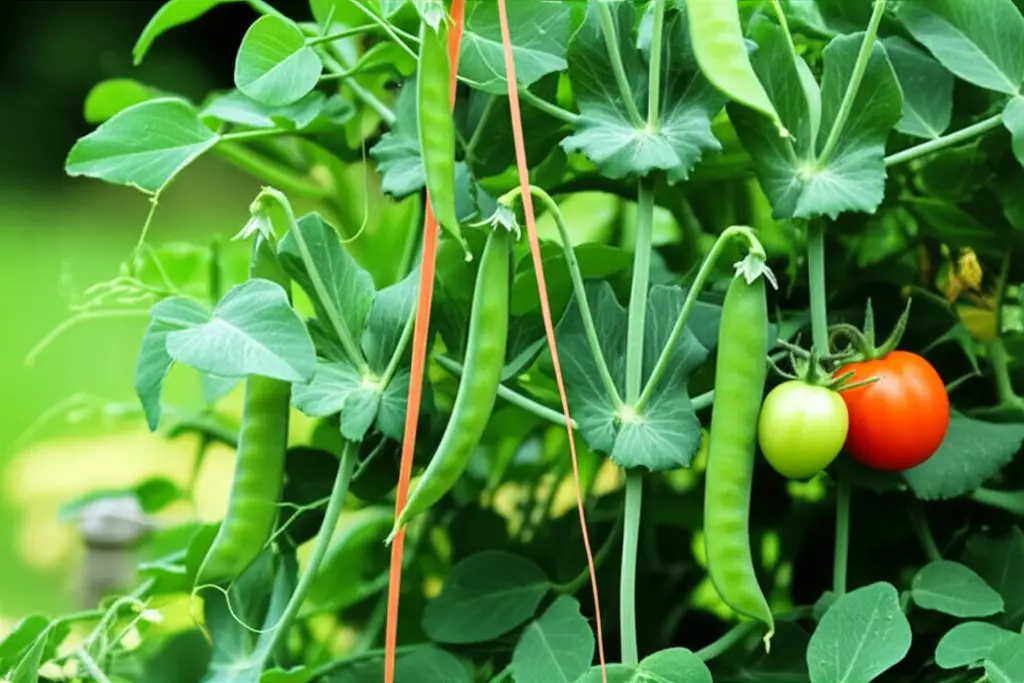Discover the symbiotic relationship between peas and tomatoes and how companion planting these two crops can lead to healthier plants, increased yields, and a more vibrant garden.

Companion planting, the practice of growing different plant species together for mutual benefit, offers numerous advantages. This post delves into the specifics of pairing peas and tomatoes, exploring the scientific basis for their compatibility and providing practical tips for successful companion planting.
JUMP TO TOPIC
The Dynamic Duo: Why Peas and Tomatoes Thrive Together
Companion planting isn’t just folklore; it’s rooted in scientific principles. Certain plants, like peas and tomatoes, have complementary needs and offer reciprocal benefits when grown in proximity.
Nitrogen Fixation: Peas as Natural Fertilizers
Peas belong to the legume family, renowned for their nitrogen-fixing capabilities. Through a symbiotic relationship with bacteria in their root nodules, peas convert atmospheric nitrogen into a usable form for plants. This process enriches the soil, providing a readily available nitrogen source for neighboring tomatoes, which are heavy nitrogen feeders. This natural fertilization reduces the need for synthetic nitrogen fertilizers, promoting a healthier soil ecosystem and minimizing environmental impact. Learn more about nitrogen fixation and its benefits.
Pest Deterrence: A Natural Defense System
Tomatoes emit solanine, a compound known to deter certain pests that commonly affect pea plants, such as aphids. The scent of tomato foliage can mask the pea plants, making them less attractive to these pests. Conversely, peas attract beneficial insects like ladybugs and lacewings, which prey on tomato pests like aphids, mites, and whiteflies. This natural pest control mechanism minimizes the need for chemical pesticides, leading to a healthier and more balanced garden ecosystem. Explore further on natural pest control methods in gardening.
Practical Tips for Successful Pea & Tomato Companion Planting
Successfully pairing peas and tomatoes requires some planning and execution. Here are some key points to consider:
Timing is Key: Planting Schedules for Optimal Growth
Peas thrive in cooler temperatures and should be sown in early spring, a few weeks before the last expected frost. Tomatoes, on the other hand, prefer warmer weather and should be planted after the danger of frost has passed. To optimize the benefits of companion planting, stagger the planting times. Plant your peas first, allowing them to establish a strong root system and begin nitrogen fixation. Then, plant your tomato seedlings a few weeks later, once the soil has warmed up. You can find detailed information on planting schedules for various vegetables.
Spacing and Support: Giving Each Plant Room to Thrive
Adequate spacing is crucial for successful companion planting. Overcrowding can lead to competition for resources and hinder the growth of both plants. Space pea plants 2-3 inches apart, providing trellises or other support structures for climbing varieties. Tomato plants require more space and should be planted 2-3 feet apart, depending on the variety. Ensure sufficient spacing between pea and tomato rows to allow for adequate air circulation and sunlight penetration. For guidance on supporting climbing plants, visit our dedicated guide.
Watering and Fertilizing: Meeting Their Needs
Both peas and tomatoes require consistent watering, especially during dry periods. However, avoid overwatering, as this can lead to root rot and other fungal diseases. Monitor the soil moisture regularly and water deeply when the top inch of soil feels dry. While peas provide nitrogen to the soil, tomatoes also benefit from supplemental feeding with a balanced fertilizer, particularly during fruiting. Choose a fertilizer with a lower nitrogen content to avoid excessive vegetative growth at the expense of fruit production. Check out our guide to watering and fertilizing your garden.
Variety Selection: Choosing Compatible Cultivars
Consider the growth habits of different pea and tomato varieties when planning your companion planting. Bush beans are a good choice for smaller gardens or containers, while pole beans require vertical support. Determinate tomatoes are compact and ideal for containers or small spaces, whereas indeterminate varieties require staking or caging and can grow quite large. Select varieties that complement each other in terms of size and growth pattern.
Debunking Common Myths About Pea & Tomato Companion Planting
Several misconceptions exist about companion planting, and it’s crucial to address them.
Myth: Peas inhibit tomato growth. This is false. While some plants exhibit allelopathic effects (inhibiting the growth of neighboring plants), peas and tomatoes have a symbiotic relationship.
Myth: All pea varieties are suitable for companion planting with tomatoes. Although most pea varieties provide nitrogen fixation, dwarf varieties are generally a better choice due to their smaller size and lower risk of overshadowing tomato seedlings.
FAQs: Pea & Tomato Companion Planting
Q: Can I plant peas and tomatoes in the same pot?
A: Yes, you can plant peas and tomatoes together in a large pot, but ensure the pot is big enough to accommodate both plants and provide adequate spacing.
Q: Do I still need to fertilize my tomatoes if I plant them with peas?
A: While peas provide nitrogen, tomatoes benefit from a balanced fertilizer during fruiting.
Q: What other plants are good companions for tomatoes?
A: Basil, carrots, and marigolds are also excellent companions for tomatoes.
Q: Can I plant peas after tomatoes in the same spot?
A: Crop rotation is recommended. Avoid planting peas in the same spot where tomatoes grew the previous season to prevent the buildup of soilborne diseases.
Conclusion
Companion planting peas and tomatoes offers numerous benefits, from natural pest control and fertilization to improved soil health and increased yields. By understanding the principles behind this symbiotic relationship and following the practical tips outlined above, you can create a thriving garden ecosystem and enjoy the abundant harvest that results from this dynamic duo. Remember to consider the specific needs of each plant, providing adequate spacing, sunlight, and water for optimal growth. With a little planning and care, companion planting can unlock the full potential of your garden and bring you closer to a more sustainable and rewarding gardening experience.

